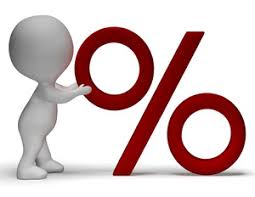I hope you're having a lovely half term so far- I know I've been incredibly busy, catching up with friends and family but before we broke off I had a few requests for some activities for the blog so, here we are...
The first topic I want to go over with you is percentages- they can be a little daunting but in actual fact they're quite simple so keep reading to find out more!
Calculating a percentage of an amount
So, I always find it useful to clarify what 'percent' means first of all. 'Per' means out of or every (e.g. I eat 3 meals per day) and 'cent' means 100 (e.g. there are 100 years in a century).
So when we are looking for 15%, what we are actually saying is we want 15 out of 100. This video from Khan Academy might also help you to understand this a little better, just click the image and it should take you where you need to go to watch it.
Now, I always find it useful to be able to find 1% and 10% as these are really useful percentages to help you figure out any other percent.
So, to find 1%, all you have to do is divide the amount you have by 100! When we divide a number, it gets reduced, so all the digits will move to the right. When dividing by 100 we move the digits 2 places to the right (think of the 2 zeros in the number 100 to help you remember that).
e.g.
- 1% of 200 = 2
- 1% of 8000 = 80
- 1% of 450 = 4.5
Notice that the answer doesn't have to be a whole number; it can be a decimal too!
Try these:
- 1% of 890 =
- 1% of 1000 =
- 1% of 3567 =
- 1% of 780367 =
Next let's look at finding 10%. To do this, you divide the amount you start with by 10. When we divide a number, it gets reduced, so all the digits will move to the right. When dividing by 10 we move the digits 1 place to the right (think of the 1 zero in the number 10 to help you remember that).
e.g.
- 10% of 200 = 20
- 10% of 8000 = 800
- 10% of 450 = 45
Try these:
- 10% of 890 =
- 10% of 1000 =
- 10% of 3567 =
- 10% of 780367 =
So what do you do if you are asked to calculate 23% of an amount for example?
Easy... Let's use this as an example...
What is 23% of 200?
From the calculations we did above, we already know that 1% of 200 is 2 and 10% of 200 is 20.
I find it easiest to partition fractions down, so rather than finding 23%, I will calculate 20% and 3% and add them together...
- Because I know that 10% of 200 is 20, then 20% is double that so 20% = 20 x 2 = 40.
- Because I know that 1% of 200 is 2, then 3% is 3 times as much so 3% = 2 x 3 = 6.
- Now I just add them together:
40 + 6 = 46
Let's try another...
What is 57% of 200?
So again I am going to partition 57% in to 50% and 7%
- Because I know that 10% of 200 is 20, then 50% is 5 times as much, so 50% = 20 x 5 = 100.
Now to tackle the 7%... There are 2 possible ways to do this:
I could use my knowledge of 1% and multiply this by 7
- Because I know that 1% of 200 is 2, then 7% is 7 times as much so 7% = 2 x 7 = 14
- Because I know that 10% of 200 is 20, then 5% is half as much, so 5% = 20 divided by 2 = 10
- Because I know that 1% of 200 is 2, then 2% is 2 times as much so 2% = 2 x 2 = 4
- Now I can add the 5% (10) and 2% (4) together to get 7% (14)
Finally, to find 57% I simply add the 50% (100) to the 7% (14) to get 57%:
100 + 14 = 114
Now have a go at calculating the following percentages of amounts:
- 12% of 8000
- 34% of 450
- 75% of 200
- 63% of 450
- 48% of 8000
- 71% of 200

No comments:
Post a Comment